Ficus Benjamina - a beautiful "birch" on the windowsill
Many believe that ficus should be kept in the house, because this plant is the keeper of the hearth and attracts peace and harmony to the house. In addition, ficuses are able to purify indoor air. Such a flower will easily fit into any interior, bringing a touch of tropical exoticism.
Though ficus benjamin came from tropical countries and is quite capricious, he has adapted well to home conditions and it is not difficult to take care of him.
In the Australian and Asian expanses, Benjamin's ficus grows in natural conditions and its size is about twenty meters. Apartment associates reach more modest sizes, but are not inferior in decorativeness and useful properties.
Content:
- What does the ficus "birch" look like
- In what conditions do you need to keep the plant
- How ficus reproduces
- Competent care of ficus
- Transplant features
- How to deal with diseases and pests
What does the ficus "birch" look like
Ficus Benjamina (Ficus Benjamina), and common people ficus birch refers to decorative deciduous plants from the Mulberry family. It is often used for landscaping premises.
This plant is a large bush or tree, the lush crown of which consists of erect and drooping decorative shoots.
On them there are graceful ellipsoid leaves with a pointed tip of a monochromatic green or variegated color. The standard sheet length is from seven to twelve centimeters. The sunken central veins are clearly visible. Young leaves are softer and lighter than mature ones.
In the apartment, the ficus "Birch" can grow up to two meters. They have very developed roots, which must be taken into account when choosing a planting capacity. There are many species and varieties of Benjamin ficus, the differences in which are in the size, shape and color of the leaves, as well as in the degree of adaptability to outdoor or indoor cultivation.
In what conditions do you need to keep the plant
It is not difficult to determine what conditions the ficus "birch" needs. Observing the plant, you can determine its dislike for an excess of sun and movement from one place to another. If the ficus feels comfortable, then it grows rapidly. And for this he needs a sufficient amount of heat and high humidity, as in his homeland.
When choosing a place for a ficus "birch", it should be remembered that a lack of light will lead to a loss of decorativeness of variegated foliage - it will fade, and contrasting spots and strokes will become invisible. But at the same time, the plant should not be allowed to be exposed to direct sunlight - this will lead to disease and death of the flower.
Considering that ficus - the plant is evergreen and does not have a pronounced rest period, you need to take care of it all year round:
- in spring, summer and autumn, ficus needs a temperature of 21 to 29 degrees
- in winter, it is allowed to lower the temperature regime by 4-8 degrees. But if the thermometer falls below 14, then the plant will show its dissatisfaction with the oppressed state and rapid leaf fall
In addition to the appropriate temperature and illumination, the ficus "birch" needs high humidity, which should not be lower than 70-75%.In summer, ficus will not give up a warm shower that replaces tropical showers. And in winter, you need to spray the leaves with water every day or turn on an electric humidifier.
How ficus reproduces
Ficus propagation occurs by cuttings or by rooting a leaf. A favorable period for such manipulations is the spring-summer period.
Plant propagation methods:
- Cuttings... A simpler and more common way. It is necessary to select a stalk 9-12 cm long with two pairs of developed healthy leaves. There are two ways to root cuttings: by placing them in a container of water or immersing them in moist soil. With any method, you need to maintain the air temperature within 26-28 degrees, and to speed up the process, create greenhouse conditions by covering the cuttings with a film. The first roots will appear after 10-15 days, and the plant will be ready to be transplanted into a flowerpot. The planting capacity should not be large, 10 cm in diameter is enough. Rooting will be more effective in greenhouse conditions.
- Rooting the leaf. For this method, you need to separate the leaves closest to the ground and place them in a container of water. To prevent the stalks from rotting, a tablet of activated charcoal or aspirin is dissolved in water. If the leaves are cut with part of the stem, then rooting can be carried out in wet soil. In this case, it is necessary to provide greenhouse conditions and optimal lighting. After the roots appear, young ficuses are seated in individual small containers.
Competent care of ficus
Ficuses are quite capricious in content, but it will not be difficult to provide them with proper care. It is enough to follow some rules:
- The soil. Many flower growers recommend purchasing a ready-made soil mixture for fixing, which contains peat, sand and leafy earth in equal parts. And you can also prepare the mixture yourself by mixing leaf peat, sod soil and sand in equal proportions, or peat (2 parts), leafy soil (1 part) and humus (1 part).
- Irrigation. The roots of the ficus "birch" need constantly moist soil, so watering is carried out regularly, as the soil dries up to a fifth of the pot. Water should be poured not into the center, but along the edges of the pot in portions so that the soil is saturated evenly. Excess water is drained from the pan. Mature specimens can be immersed in water so that the earth draws out the right amount of moisture. In winter, watering is reduced, but does not allow the soil to dry out.
- Top dressing... The main nutrient feeding "birch" is given in the first half of spring (once a month), when the period of active growth of the plant begins. Subsequent fertilizers are supportive and gradually increase in frequency: at first, up to once every three weeks, and then up to twice a month. For top dressing, you can use a complex universal fertilizer for decorative deciduous plants. Stop feeding if the plant has dropped its foliage in winter. Ficuses also respond positively to sugar feeding - the foliage becomes shiny and rich. Sugar is sprinkled on the topsoil or added to the irrigation water.
- Pruning. A necessary element of ficus care is pruning in order to crown formation... With the help of pruning, various shapes can be achieved, but most often they are formed: spherical, bushy, tiered, sculptural, in the style bonsai... Pruning is carried out in the spring and first month of summer, when the plant is actively developing. You should also take into account the age of the ficus. Young plants are easier to form and easier to tolerate intervention. Pruning is mandatory if the ficus has grown greatly and has lost its attractiveness. If pruning is not necessary, then in the spring damaged and dried branches, as well as elongated and growing shoots inside the crown, should be removed.If this procedure is neglected, then heat and air exchange in the crown becomes difficult, and the risk of infection of the plant with parasites and diseases also increases.
Carrying out the pruning procedure, you need to follow a number of rules:
- Maintain the natural look of the flower.
- Use sterile instruments.
- Do not injure the bark.
- Observe the angle of the cuts towards the top.
You can form a unique crown by interweaving the trunks. To do this, in one pot there should be several young specimens, approximately equal in size. In the process of growth, the shoots twist together and fix the plexus with a cord. Once the trunks are in the correct position, the mounts can be removed.
Transplant features
Ficus Benjamin is transplanted in the case of:
- tightness of the planting tank, as indicated by roots above the soil surface or protruding from the drainage holes
- lack of soil, when only one roots, crushed by the soil, remain in the pot
- soil depletion
- poor quality drainage
If the transplant is not indicated for the ficus, then a layer of fertile soil should be regularly poured into the pot. When transplanting, it is undesirable to touch the roots and clean them from the ground completely, because it is easy to harm the plant with such actions. The best way of transplanting is considered to be transshipment.
How to deal with diseases and pests
Most often, the ficus "birch" suffers from fungal diseases:
- Powdery mildew most dangerous for ficuses. It is manifested by the formation of a grayish coating on the surface of the leaves. It is distinguished by its rapid development and quickly destroys the plant. Control measures: removal of damaged parts of the flower, treatment of plants with sulfur-containing preparations and airing.
- Leaf spot is manifested by the formation of brown or brown spots of different size and shape on the leaf blade, which gradually grow, covering the entire leaf. If you do not take action, then over time the plant will die. Control measures: plants are treated with Bordeaux liquid, after removing the affected parts.
- Gray rot - develops due to excess moisture and stagnant air. First of all, the roots are affected, and over time, the disease spreads to the root collar and stem. Control measures: plant transplant and removal of affected parts, treatment with manganese solution and creation of acceptable living conditions.
- Sooty fungus - the upper parts of the shoots or the tips of young leaves turn black, which makes it difficult for air to penetrate the plant tissues. The ficus begins to wither. The development of a sooty fungus often occurs due to damage by pests, therefore, the fight against it should be carried out comprehensively. To destroy the fungus itself, you need to wipe the leaves with soapy water.
- Fusarium - affects the root system of the flower, the leaves turn yellow and wither. Occurs with excessive moisture. Control measures: carry out a sanitary plant transplant, removing damaged parts, reduce watering, provide fresh air.
In addition to diseases, the ficus "birch" can be attacked by parasitic insects:
- scabbard
- mealybug
- spider mite
To get rid of insects, you need to treat the plants with a concentrated soap solution, and in case of severe damage - with systemic fungicides... You should also remove parasites mechanically and remove heavily damaged parts of the plant. When fighting spider mites, the air humidity should be reduced. Existing beliefs about ficus say that if the plant takes root and grows in the house of a childless couple, then they will soon have a baby.
More information can be found in the video:



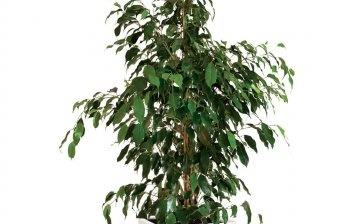
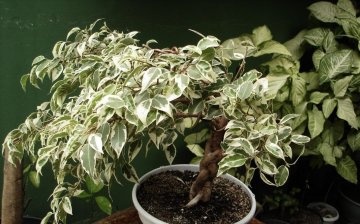
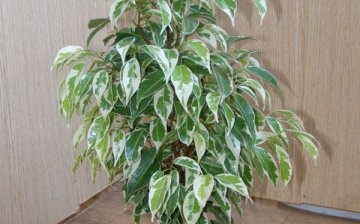
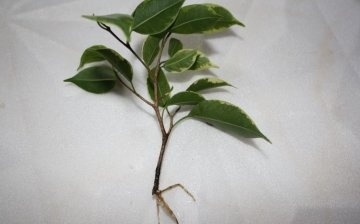
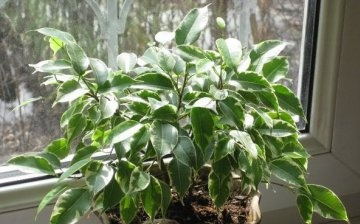









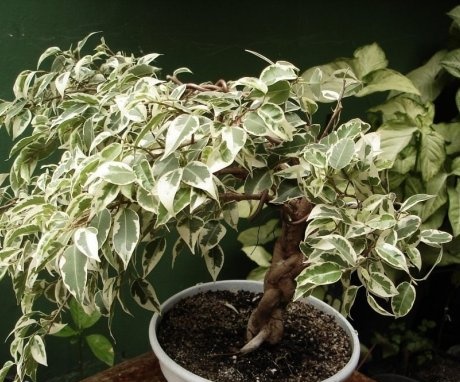
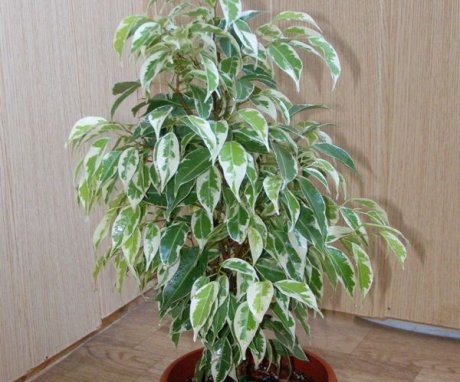




I really like this plant. I have a ficus plant with ordinary, monochromatic leaves. I also want to have a "birch" with white and green foliage. The plant is not whimsical in its care, it does not get sick for me, I periodically fertilize it, it grows perfectly even in the shade.